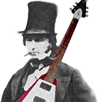Harmonising the Major scale
(…in other words, where chords come from)
- The notes in the key of C major are C D E F G A B
- The C major scale contains no sharps (#) or flats (b)
- From the above 7 notes, 7 chords can be generated:
– 3 major chords C, F and G
– 3 minor chords Dm, Em and Am
– and 1 diminished chord B dim
Here is how to find the chords in any key:
- Take the notes of any major scale In this case (for simplicity because it contains no sharps or flats) we are using C major
C D E F G A B
Give each note a number from 1-7
| C | D | E | F | G | A | B |
| 1st | 2nd | 3rd | 4th | 5th | 6th | 7th |
- Take the 1st (which we will call the root and will become the name of the chord), the 3rd and the 5th and play them all at the same time
| C | D | E | F | G | A | B |
| 1st | 3rd | 5th |
The result will be a C major chord.
Note: This is a MAJOR chord because the interval (distance) between the root (C) and the 3rd (E) is two tones = 4 frets. This is the definition of a major chord.
- Next, do exactly the same thing but this time starting from the next note of the C major scale.
| C | D | E | F | G | A | B | C |
| (7th) | 1st | 2nd | 3rd | 4th | 5th | 6th | 7th |
Notice that now we are calling D the 1st (the root), which makes F the 3rd and A the 5th
The result will be a D minor chord.
Note: This is a MINOR chord because the interval (distance) between the root (D) and the 3rd (F) is one and a half tones = 3 frets. This is the definition of a minor chord.
- If we repeat the same thing over for every note of the scale we end up with this:
| Notes | Chords | Chord Number |
| CEG | C major | I |
| DFA | D minor | II |
| EGB | E minor | III |
| FAC | F major | IV |
| GBD | G major | V |
| ACE | A minor | VI |
| BDF | B diminished | VII |
NOTE: Where the first 6 chords have a perfect 5th, the last one, a diminished chord, has a minor 3rd and a flattened (or diminished) 5th
Each of these seven chords contains 3 notes, they are therefore known as TRIADS
To recap, all the triads below are in the key of C major and derive from (and ONLY from) these 7 notes…
C D E F G A B
This pattern is the same no matter what key you are in.
MAJ- MIN- MIN- MAJ- MAJ- MIN- DIM
The harmonised triads in the key of C major are…

To determine the key centre in major chord sequences, try looking for clues of this pattern. For example, two Major chords a tone apart are likely to be chords IV and V. From this you can then work out what chord I is, which will be your key.
